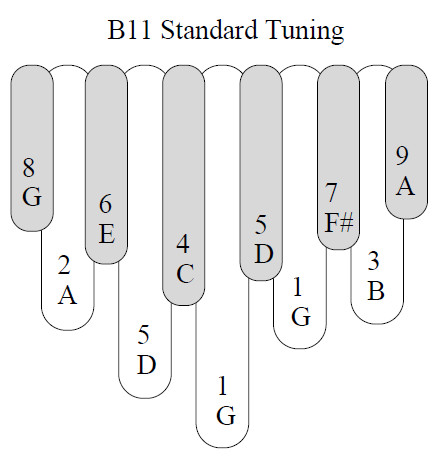When you start playing your kalimba, on which note do you start? Most people think the low(est) note is where they should start – and they tend to play their kalimba in that key. However, you can play your kalimba emphasizing other notes, and not only do you play in a different “key” in each case, but you will also play with a different scale or mode… and each scale gives your kalimba playing a different flavor.
If you have a B11 kalimba, watch this video of B11 multi-mode music. you can learn these “tricks” and understand how to play this way yourself.
And even if you don’t have the B11 kalimba, this lesson can be applied to other kalimbas! Check it out!
The simple 9-Note Sansula, or Hokema B9, has been a spectacular, emotive instrument that people have loved for almost 20 years. If you’ve played the 9-Note, it may be time to move up to the B11. While the Sansula is charming and beautiful, there are precious few songs you can play on it. The B11 has another name – the “Melody,” and that is because it lends itself to making melodies with simple accompaniment.
In other words, if you seem to be at a dead end with the Sansula, you might want to check out the B11, because there is so much more music you can do with it!
And to emphasize the range of what you can do with the B11 Melody kalimba, I have included at the bottom of this page a video of me on a standard-tuned B11, playing in six consecutive different modes. Look at the accompanying B11 tuning chart, and then play the video. From 0:00 to 0:26 and you will find that my playing emphasizes the “C” tine in several ways. It will put the C note at the start of a measure, or it will use the 5th of C – that is, G – to point to C as the root note. Runs will tend to start and stop on the C note. And in each section with a different mode, you can similarly follow the root note, in the tablature and the video.
Most of these modes have one 4-measure column of tablature written for them. That column is repeated, taking up about 13 seconds in the video. Can you follow along with the tablature in the video? When the kalimba is on the left side of the image, I am reading from the right page of the book – either from the first column… or, when the music changes mode, from the second column of tablature on that page.
By the way, the gray columns represent the upper-row tines, and the white columns represent the lower-row tines. The first 26 seconds of the video is dominated by upper-row tines, and you can see that the corresponding music in the tablature is almost all on gray columns.

0:00 – 0:26 is in C Lydian (major) Mode
0:26 – 0:39 is in A Dorian (minor) Mode
0:39 – 0:52 is in D Mixolydian (major) Mode
0:52 – 1:05 is in B Phrygian (minor) Mode
1:05 – 1:18 is in G Major (Ionian Mode)
1:18 – 1:32 is in E Aeolian (natural minor) Mode
1:32 through to the end is in G Major (Ionian Mode)
The video is the last piece of music in my book: “Exploring the Hokema B11 Kalimba.” It is one of the more difficult pieces in the book. But it shows you the breadth of melodic scales to which you have access on this instrument. Of course, most of the rest of the exercises in this book are much easier. You can start into this book as a pure beginner.
When you are ready to start on the path to discovering what the B11 Melody Kalimba can do, remember to pick up this book to help you find the way.


Sign up for our newsletter and free resources with your email address:
We pinky promise not to spam you and to only send good stuff.
 Christmas in July 2025
Christmas in July 2025 Patriotic and American Music for Kalimba
Patriotic and American Music for Kalimba